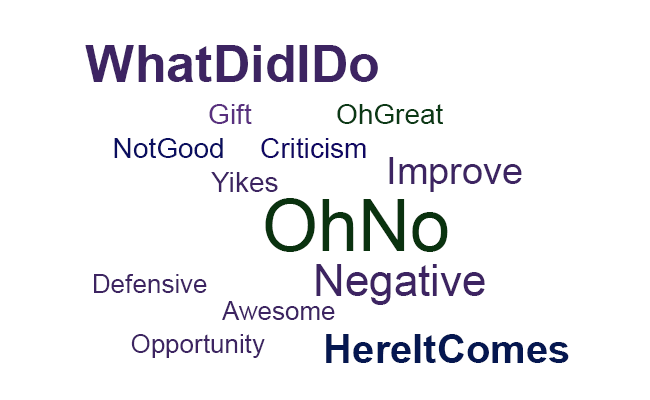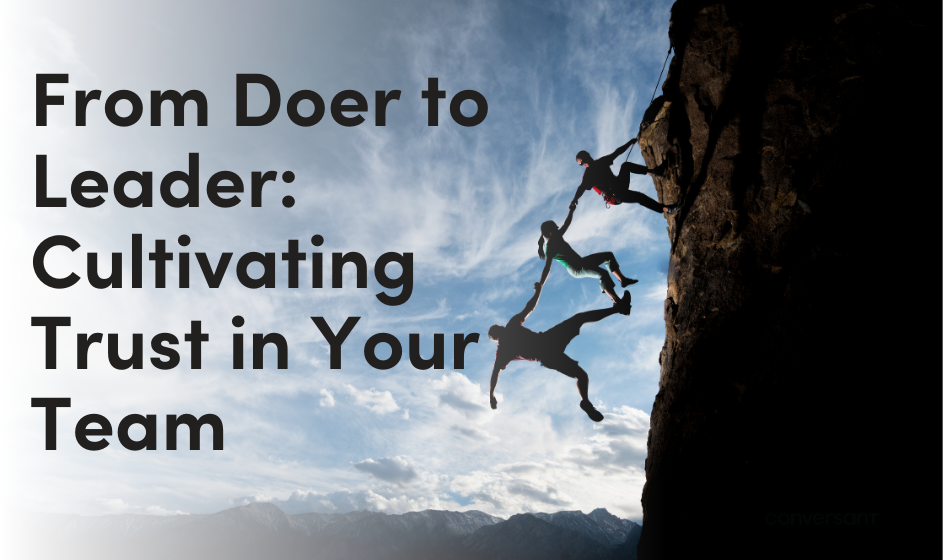This blog was co-authored by Robin Anselmi and Kell Delaney.
"Can I give you some feedback?"
Please stop for 10 seconds and write down the immediate feelings you have after reading that sentence. We'll wait...
If you are like the vast majority of our clients, your immediate reactions probably look something like this word cloud from a recent group of about 50 managers when we asked them the same question:

For just about everyone there’s a slight twinge we get somewhere in our bodies when someone says those words. Even for those among you who are highly evolved and say, “I love feedback! Feedback is a gift!” Of course, some of you say that because you think you’re supposed to feel that way. Whether you really mean it or not may be a completely different story.
"All means prove but blunt instruments, if they have not behind them a living spirit."
Albert Einstein
"All means prove but blunt instruments, if they have not behind them a living spirit."
Albert Einstein
Of course, the question is, a tool used for what? In our experience, too often the tool is used either to “correct” a particular employee’s behavior or it is done as a step toward having enough justification to allow an employee to, ahem, “apply their talents elsewhere.”
It really is unfortunate that this method, which has the potential to create great insights, has been used more for punishment than growth. But there is a way to reclaim this valuable tool and use it to advance both culture and strategy.
360s as a Tool for Culture & Strategy: Unlocking Contribution
Mindset is Everything
The mindset leaders bring to why they are using a 360 will determine (and limit) its potential. We have already said that using it to punish or correct will limit its use and, most importantly, limit how receptive team members are to using it. If it is truly used for development—to help someone enhance their contribution by identifying their strengths that may be going unrecognized—you will find the organization gets excited about the possibilities. Align it to culture (either the one you love and are trying to maintain or the one you are trying to create) and it starts to communicate to everyone, “Here’s what matters around here.”
So, before you dive in: what are you using a 360 for?
Start with Appreciation
Everyone wants to jump to the “what to improve” section. Instead, we always start with a person’s strengths: how do those show up throughout the 360 results? Where are they a real asset to the culture? What are they most proud of, and where have they applied effort? What results have they seen because of their effort? Spend most of your time debriefing here.
Applying their Strengths
When looking at opportunities for improvement, look at how their strengths can be applied in those areas. See if they're overusing their strengths here, or if they're using a strength to defend a point of view or forward their own agenda rather than applying it on behalf of a team purpose or goal.
The funny thing is, if you focus on where someone is already shining and grow that contribution, they're likely to have the willing energy to contribute more of themselves. And, the bonus here, many of the problems or challenges they are facing will fade away and no longer need to be “fixed.” The problems and challenges that are truly getting in the way will stick around and become glaringly obvious. Because those challenges are preventing the person from fully realizing their newfound contribution, they will be more motivated to understand what is truly necessary to improve them.
Superhero Culture
This leads us to another point of caution. If you pause and reflect, you quickly realize that we are living in a superhero culture—a culture that admires the people who “do it all” and do it perfectly. That amazing person who can swoop in and solve any problem all on their own. So, we do our best to appear perfect and amazing at our work, and any criticism or “feedback” we receive makes us tense and self-critical. This is both a ridiculous and impossible bar to meet. We evolved to function best as a collective, a team, a community, complementing one another’s weaknesses with our strengths so that together, we are a superhero team that is good at far more than any of us could ever be individually.
Besides, trying to be a superhero is exhausting. When we let go of the drive to be the best at everything, we are freed to give more energy to what we are best at, thereby serving our teams, customers, and clients even better, both individually and collectively.
Smarter Together
As a result of our superhero mentality, we most often coach only to the individual. That is partially useful but does not get the full value out of the 360. Sure, a 360 assessment is about a particular individual, but no one (and I mean no one) works devoid of interactions with other people. We all work as part of a team or network of individuals coordinating to make something happen together. It stands to reason that we would therefore conduct 360 assessments together as a team. (In situations where there is not a coherent team, identify and bring together the collection of people who are depending on one another to do their work well.) The crazy thing is that we easily recognize our interconnections with others when we ask them to contribute feedback to a 360 assessment, but then we turn around and coach to the individual as if the community of people they interact with are no longer relevant.
So, it makes sense to focus most of our time and energy on identifying and growing our individual strengths, then making a connection to how this makes us a unique and crucial contributor to a team. If teams go through a 360 process together and then share what they have learned with one another, the newfound awareness of one another’s strengths and best contribution will allow the team to coordinate their work in ways that were previously being missed completely.
The most valuable, enjoyable, and sustainable 360 experiences we run collect input about individuals, coach to that individual, and then connect the feedback and outcomes to the larger community they are a part of. Give your team the opportunity to share highlights from their individual 360 experiences with one another, proudly share where and how they wish to contribute more fully, and then host a conversation about how they will collectively combine all their strengths to be better together. This is a truly powerful, connecting, and joyful experience of “feedback.”
Advancing Culture & Strategy
360s can also be a method for advancing both culture and strategy when they are used to make us smarter together. When a team looks at their collective 360 results, they can see patterns and habits—both the ones that could be leveraged further and the ones that might be getting in their way. They can see default or habitual ways of behaving that might be limiting their strategic view, or ways that the team is behaving that’s not in alignment with an intended culture.
Creating space for these open conversations and connecting feedback and performance expectations to culture and strategy is a living demonstration that leadership is truly invested in the culture and strategic vision, and that they are committed to seeing it through.
Already investing in 360 assessments? There are a number of ways to ensure you’re getting the greatest possible value out of them. Focused on strategy execution or culture change? 360s can be a valuable tool in driving new individual, team, and organization-wide behaviors. If you’re interested in advancing your culture or strategy, or wish you had greater degrees of aligned action on your team, we’d love to have a conversation with you about what would best serve those goals.




